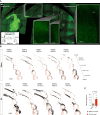Commissural dentate granule cell projections and their rapid formation in the adult brain
- PMID: 37077887
- PMCID: PMC10109062
- DOI: 10.1093/pnasnexus/pgad088
Commissural dentate granule cell projections and their rapid formation in the adult brain
Abstract
Dentate granule cells (GCs) have been characterized as unilaterally projecting neurons within each hippocampus. Here, we describe a unique class, the commissural GCs, which atypically project to the contralateral hippocampus in mice. Although commissural GCs are rare in the healthy brain, their number and contralateral axon density rapidly increase in a rodent model of temporal lobe epilepsies. In this model, commissural GC axon growth appears together with the well-studied hippocampal mossy fiber sprouting and may be important for the pathomechanisms of epilepsy. Our results augment the current view on hippocampal GC diversity and demonstrate powerful activation of a commissural wiring program in the adult brain.
Keywords: adult brain; circuit formation; commissural axon; contralateral projection; hippocampal granule cell; sprouting.
© The Author(s) 2023. Published by Oxford University Press on behalf of National Academy of Sciences.
Figures





Similar articles
-
Lesion-induced synapse reorganization in the hippocampus of cats: sprouting of entorhinal, commissural/associational, and mossy fiber projections after unilateral entorhinal cortex lesions, with comments on the normal organization of these pathways.Hippocampus. 1992 Jul;2(3):247-68. doi: 10.1002/hipo.450020305. Hippocampus. 1992. PMID: 1284974
-
Loss of dynorphin-mediated inhibition of voltage-dependent Ca2+ currents in hippocampal granule cells isolated from epilepsy patients is associated with mossy fiber sprouting.Neuroscience. 1999;94(2):465-71. doi: 10.1016/s0306-4522(99)00249-3. Neuroscience. 1999. PMID: 10579209
-
Stereologic estimation of hippocampal GluR2/3- and calretinin-immunoreactive hilar neurons (presumptive mossy cells) in two mouse models of temporal lobe epilepsy.Epilepsia. 2011 Sep;52(9):1579-89. doi: 10.1111/j.1528-1167.2011.03086.x. Epub 2011 Jun 2. Epilepsia. 2011. PMID: 21635231
-
Mossy fiber sprouting as a potential therapeutic target for epilepsy.Curr Neurovasc Res. 2004 Jan;1(1):3-10. doi: 10.2174/1567202043480242. Curr Neurovasc Res. 2004. PMID: 16181061 Review.
-
Signaling Pathways and Cellular Mechanisms Regulating Mossy Fiber Sprouting in the Development of Epilepsy.Front Neurol. 2018 May 3;9:298. doi: 10.3389/fneur.2018.00298. eCollection 2018. Front Neurol. 2018. PMID: 29774009 Free PMC article. Review.
Cited by
-
Perirhinal cortex abnormalities impair hippocampal plasticity and learning in Scn2a, Fmr1, and Cdkl5 autism mouse models.Sci Adv. 2025 Mar 7;11(10):eadt0780. doi: 10.1126/sciadv.adt0780. Epub 2025 Mar 7. Sci Adv. 2025. PMID: 40053578 Free PMC article.
-
Cell-type-specific expression of tRNAs in the brain regulates cellular homeostasis.Neuron. 2024 May 1;112(9):1397-1415.e6. doi: 10.1016/j.neuron.2024.01.028. Epub 2024 Feb 19. Neuron. 2024. PMID: 38377989 Free PMC article.
-
Activation of feedforward wiring in adult hippocampal neurons by the basic-helix-loop-helix transcription factor Ascl4.PNAS Nexus. 2024 May 3;3(5):pgae174. doi: 10.1093/pnasnexus/pgae174. eCollection 2024 May. PNAS Nexus. 2024. PMID: 38711810 Free PMC article.
-
Generation of an enhancer-driven gene expression viral tool specific to dentate granule cell-types through direct hippocampal injection.Front Neurosci. 2024 Mar 14;18:1274174. doi: 10.3389/fnins.2024.1274174. eCollection 2024. Front Neurosci. 2024. PMID: 38550563 Free PMC article.
References
-
- Denoth-Lippuner A, Jessberger S. 2021. Formation and integration of new neurons in the adult hippocampus. Nat Rev Neurosci. 22(4):223–236. - PubMed
-
- 2012. Jasper's basic mechanisms of the epilepsies [internet]. 4th edition. Bethesda: (MD: ): National Center for Biotechnology Information (US). - PubMed
LinkOut - more resources
Full Text Sources
Molecular Biology Databases
Miscellaneous

